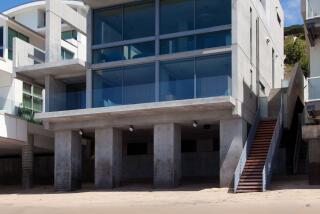Planned house demolition upsets Malibu neighbors
A New York hedge fund manager’s plan to demolish an eye-catching steel-and-glass home in Malibu and build a two-story California Mission-style residence has neighbors in a lather over the potential loss of ocean views and what some decry as the waste of a perfectly good house.
Once described as among the most significant new structures in Malibu, the building slated for destruction was designed by architect Bart Prince and hugs the slope in a neighborhood of private tennis courts, swimming pools and lush lawns.
Among Point Dume residents who are urging preservation of the house — as well as million-dollar views — are Julia Roberts, Sean Penn, Don Rickles and Chad Smith, drummer for the Red Hot Chili Peppers.
“In my wildest dreams, I would never, ever have thought it would be possible for someone to build closer to our home … and also into the view of what you know is so precious to us and our family,” said Smith, who lives next door and is leading the effort to stop the project. “It blows me away that this is possible.”
To some, the controversy recalls other high-profile battles over coastal lands.
U2 guitarist the Edge, whose real name is David Evans, has for years encountered blowback from the California Coastal Commission and residents over plans to build five widely spaced mansions on a scenic ridge top. And in 2003, TV tycoon A. Jerrold Perenchio tussled with the coastal panel after environmental activists blew the whistle on his unpermitted pitch-and-putt golf course in the exclusive Malibu Colony.
But this preservation battle is unique in that the Prince-designed house was completed only in 2005. Although it was showcased by the late architectural photographer Julius Shulman in his book “Malibu: A Century of Living by the Sea,” would-be preservationists are finding it tough to lay claim to historical significance.
The one-acre Point Dume property at 28827 Grayfox St. was bought in 2010 by the Sogel Family Trust for $6.2 million, down from the original listing price of $9.9 million, after 318 days on the market.
Behind the trust are Sean Fahey, a co-founder of Claren Road Asset Management, and his wife, Robin Luce. The couple, who have two young children, told the city that the existing 7,000-square-foot house — a series of diamond-shaped rooms that cascade down the slope — did not fit their needs or taste. They have proposed a nearly 6,900-square-foot compound with a two-story residence, detached garage, pool and cabana.
“My clients are excited to come out to Point Dume and be part of the community,” said Fiona Hutton on behalf of the Sogel Family Trust. “It’s a beautiful lot in a wonderful location.”
Supporters of Smith and his wife, Nancy Mack — including Malibu-based bandmates Josh Klinghoffer, Anthony Kiedis and Michael Balzary, known as Flea — want the city to require further review under the California Environmental Quality Act. If the project is approved, they say they fear a “domino effect” of construction as area residents attempt to recapture blocked views.
Joining in the crusade is actress Kelly Lynch, who has spent $1 million restoring her John Lautner house in Los Feliz and described as “heartbreaking” and wasteful the prospect of seeing Prince’s “masterpiece” dismantled.
“These faux Tuscan mansions that go up — they block the sky, block the sun, take up the entire site, impinge on the neighbors’ home values, beauty, sightlines,” Lynch said. “It’s an old story.”
Malibu does not have a historic preservation ordinance. Even if one existed, it almost certainly would not apply to a house so new as the one designed by Prince. Typically, properties must be at least 50 years old to be considered for landmark designation. For that reason, the Los Angeles Conservancy has chosen not to weigh in.
The city’s planning staff has recommended that the Planning Commission approve the project, saying it conforms to municipal and local coastal program codes. Earlier this month, the commission postponed its vote to allow time for the applicant to try to come to terms with neighbors.
Hutton said her clients had recently revised their plans and lowered a view-obstructing breakfast nook by 2 feet to 12 feet. Under city code, residents may build as high as 18 feet even if a structure blocks a view, said city Planning Director Joyce Parker-Bozylinski.
Frank Angel, the attorney for Smith and Mack, said the city was obligated to avoid the obstruction of private views to the greatest extent feasible. He expects the case to end up at the California Coastal Commission.
With its expansive views of mountains and sea, Point Dume has lured celebrities seeking seclusion and natural beauty. Mansions behind walls and foliage have replaced many of the modest homesteads erected by pioneering souls on the bluffs after World War II. Grayfox Street has developed a reputation as a real community, residents say, where neighbors confer over remodels to ensure that views are compromised as little as possible. Except in this case, opponents say.
Though developers are not required to discuss proposals with neighbors before submitting plans for public review, Mack and Smith say much ill will could have been avoided had their new neighbors contacted them before submitting their building plans to the city.
In the face of opposition, Hutton said, the project developers “are willing to work hard to address neighbors’ issues. They certainly want to be reasonable and collaborative.”
Building the house for its original owners, Mark Lever and Alisa Morgenthaler, was no small feat, architect Prince recalled from his base in New Mexico. The design was constrained by rules intended to protect the canyon, some of which have since been lifted. Prince’s “organic” architecture was inspired by Frank Lloyd Wright, who promoted harmony with nature.
Prince said it was his aim to let the house follow the slope of the land. The structure is steel on a masonry concrete base, with glass and copper as the main exterior materials. It was built to last, with mitered joints and custom doors and windows that open at the corners and slide back.
“It took forever to build that house,” said Robin Poirier, a contractor who supervised much of the carpentry. “The house was perfectly tailored to fit that site … so that it does not obstruct anyone’s view. … The new house … is like a gigantic billboard.”
Not long after the house was completed, Lever and Morgenthaler decided to divorce and put the property up for sale.
“The destruction of the house would be a tragedy, since it could easily be remodeled … to fulfill the new owner’s desires and requirements,” Morgenthaler said. “While I believe that a property owner should be able to do what he wants with his own property, within reason, we each have a responsibility to safeguard art, and tearing down the house would be a violation of that responsibility.”
More to Read
Sign up for Essential California
The most important California stories and recommendations in your inbox every morning.
You may occasionally receive promotional content from the Los Angeles Times.











